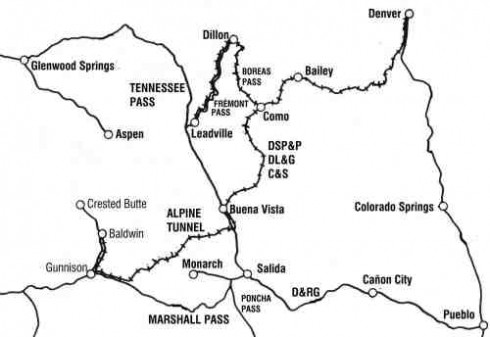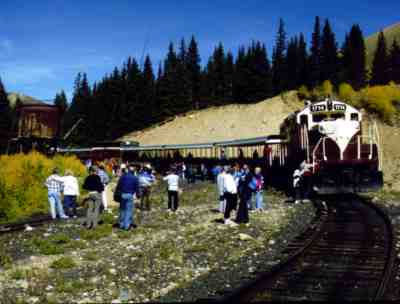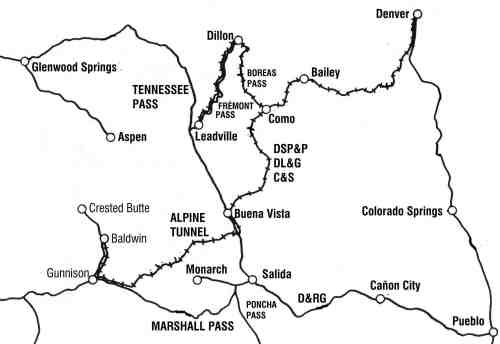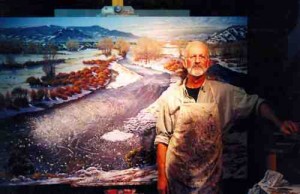Article by Ed Quillen
Transportation – September 2003 – Colorado Central Magazine
THE OFFICIAL COLORADO state highway map always showed railroads, and so over the years, quite a few people, even if they weren’t railroad buffs, must have noticed a territorial oddity that persisted from the 1930s into the 1980s.
Along the Front Range, from Denver north through Boulder and Fort Collins and on to Cheyenne, with a branch to Greeley, there was Colorado & Southern Railroad trackage. True to its name, the C&S also extended south of the capital city: a joint line with other carriers to Pueblo, then more C&S to Trinidad, then southeast toward Texas.
Up in the mountains, of course, there was the Denver & Rio Grande Western.
But right in the middle of D&RGW territory, at the highest city in the United States, there was a short, isolated C&S line that sat a good hundred miles from any other C&S trackage.
Just how that came about is a tale of battles among the titans of 19th-century American capitalism, and those battles have continued to the present day, even though the C&S and the D&RGW are no longer with us.
We can start the tale with two of Colorado’s pioneer capitalists who founded and developed cities, endowed colleges, and built railroads: John Evans and Gen. William Jackson Palmer.
Palmer came to Colorado after Civil War service as a cavalry commander, and he arrived as the builder of the Kansas Pacific, which reached Denver from the East in 1870. It wasn’t the first railroad into Denver; that honor belonged to the Denver Pacific, which connected Denver with the Union Pacific mainline at Cheyenne. One of the main movers on the DP was John Evans, an Illinois physician who came west to serve as Colorado’s second territorial governor.
Palmer and Evans both started their own narrow-gauge railroads to connect Denver to the mining camps in the mountains. Palmer’s line was the Denver & Rio Grande, which was originally planned as a north-south line to El Paso, Texas, with feeder branches that would extend west to tap the mines. Evans’s line was the Denver, South Park & Pacific, which would run from Denver to Fairplay, then southwest to whatever traffic it could find in the San Juans, and on west to the Pacific Ocean.
By 1878, it was more than clear that the best place for a railroad to go was neither El Paso nor the Pacific Ocean, but Leadville, where astounding quantities of silver were emerging from Fryer Hill. The mines needed coal for their boilers and hay for their mules. The miners needed food and drink, and the enterprises that supplied and served them needed everything from canned beans to French gowns.
WHEN THE SILVER started flowing, Palmer had built south as far as Pueblo, and west to Cañon City. Evans had built up the South Platte River from Denver and was past Two Forks and nearing Bailey. Palmer’s plan was to continue west up the Arkansas River to present-day Salida, then build a spur on north to Leadville.
What stood in his way was the Royal Gorge, or more specifically, a claim by the Atchison, Topeka & Santa Fe Railroad that it had priority on the Gorge, which was wide enough for only one line. Thus began the Royal Gorge War, which was fought with both hired gunman and hired attorneys.
The relevant part here is that the Santa Fe was controlled by Boston capitalists, and they had made an enemy of at least one New York capitalist: the infamous Jay Gould, who had already made a fortune or two by looting the Erie Railroad in New York.
Gould, in order to block Santa Fe expansion plans, started buying Rio Grande stock. And, just to be sure, he bought enough Union Pacific stock to have some say in its operations. At Gould’s behest, the Union Pacific started buying South Park stock.
So there were three powerful tycoons: Palmer with his D&RG; and Evans with his DSP&P; and in the background, Gould with the UP and some interest, either direct or indirect, in both the D&RG and the DSP&P. Both Evans and Palmer needed outside capital.
When the dust settled after the Royal Gorge War in 1879, the Santa Fe, Rio Grande, and South Park came to the “tripartite agreement” — that is, the three parties divvied up the territory. The Rio Grande and Santa Fe had battled not only for the Royal Gorge, but also for Raton Pass.
Under the tripartite agreement, Raton Pass would be Santa Fe territory henceforth, but the Santa Fe would not attempt to penetrate the Colorado mountains, which would be left to the Rio Grande and the South Park.
The Rio Grande would pretty much stay out of New Mexico for at least 10 years; the agreement specified that it could build south no farther than Espanola along its namesake river. But the D&RG could build on to Leadville.
The South Park would get the Gunnison Country, then starting to show some promise, and so after it crossed South Park and Trout Creek Pass, it began building west up Chalk Creek to the Alpine Tunnel, then down Quartz Creek to Parlin and Gunnison.
But under the tripartite agreement, it would also get a piece of the Leadville trade. It would have trackage rights on the D&RGW line along the Arkansas from Buena Vista to Leadville, and it would get about a third of the Leadville traffic.

Thus Central Colorado was parceled out between two railroads who had replaced expensive competition with some profitable cooperation — those were, after all, the days before there were anti-trust laws. The D&RG reached Leadville in the summer of 1880, and so did the DSP&P. Although the rest of its route from Denver was different, it used the same tracks as the D&RGW from Buena Vista to the Cloud City.
That arrangement might have persisted, except that Evans got a good offer for the South Park from the Union Pacific. So he sold out in 1881, and the Denver, South Park & Pacific essentially became the South Park Division of the Union Pacific.
Meanwhile, the D&RG had continued north from Leadville with two branch lines — one over Tennessee Pass to serve Red Cliff, and another over Frémont Pass to serve Kokomo and other Summit County mines. That’s part of the 20th-century oddity of the C&S line that ran in D&RGW territory; the D&RG had once had its own line over Frémont Pass (its fate will come up later).
Upon the sale of the South Park to the UP, Palmer started building west from Salida. His line went into the Gunnison Country, over Marshall Pass, while the South Park’s contractors were still struggling with the Alpine Tunnel at the head of Chalk Creek.
Evans, who was still an officer of the South Park, protested to Palmer. Wasn’t the Rio Grande bound by the tripartite agreement to stay out of the Gunnison Country?
[InContentAdTwo]
Palmer replied that his agreement had been with Evans, not with Jay Gould, who by then held controlling interest in the Union Pacific that owned the South Park. And so the Rio Grande’s first passenger train arrived in Gunnison on Aug. 8, 1881, thirteen months ahead of the South Park.
The South Park’s situation in Leadville was almost as bad. Even though the South Park had trackage rights on the line in from Buena Vista, the Rio Grande was charging exorbitant fees and giving scheduling preference to its own trains.
SO THE SOUTH PARK’S management built their own line to Leadville. Starting from Como, it climbed 11,482- foot Boreas Pass, dropped down to Breckenridge and Frisco, where there were Rio Grande tracks that had crossed Frémont Pass from Leadville. The route up that side of the pass was Ten Mile Canyon, which in some places was pretty narrow — so narrow that the Rio Grande used trespass laws to deter South Park construction.
Nonetheless, the South Park found a route over Frémont Pass and down to Leadville, and the first scheduled train arrived on Sept. 30, 1884. The best that could be said of this new connection was that it was short — only 151 miles from Denver to Leadville, as opposed to 277 via the Rio Grande. But the South Park had to cross the Continental Divide twice to reach the Cloud City, and so it didn’t save much time even if it was a shorter route.

While the Rio Grande continued to expand, the South Park kept getting reorganized under its UP ownership. By 1889, it was the Denver, Leadville & Gunnison — an accurate name, if nothing else. In 1893, America suffered a financial panic, and the Union Pacific, along with its subsidiaries, went into receivership as a way to avoid bankruptcy.
The Colorado subsidiaries got a separate receiver in 1894, and there were quite a few of them besides the old South Park line. There was the narrow-gauge Colorado Central from Golden to Idaho Springs, Central City, and Georgetown; the standard-gauge Central from Denver to Boulder and Fort Collins; the Greeley, Salt Lake & Pacific (which didn’t get much past Fort Collins); the Denver & New Orleans (another Evans project, and it had several other names) which ran south to Trinidad then southeast to meet the Fort Worth & Denver City and continue into Texas.
All these lines were removed from any UP connection and consolidated in 1898 into a new company: the Colorado & Southern (even if some of it ran north as far as Wendover, Wyo.)
IN 1908, THE Chicago, Burlington & Quincy Railroad bought a controlling interest — 64.3% — of the C&S, which explains why C&S equipment bore “Burlington Route” signs. The Burlington, in turn, had been owned since 1901 by the Great Northern and Northern Pacific railroads. Even though their ownership was connected, they had to operate separately, on account of a 1904 U.S. Supreme Court decision, the famous “Northern Securities” case wherein Theodore Roosevelt’s Department of Justice opposed the combined plans of John D. Rockefeller, J.P. Morgan, James J. Hill, and E.H. Harriman.

Meanwhile, the Rio Grande had come under Jay Gould’s son George, who was trying to build a transcontinental system with a connection to the Missouri Pacific at Pueblo and construction of the Western Pacific from Utah to the West Coast. He was being opposed by Harriman, who got control of the Union Pacific after all of the reorganization in the wake of the Panic of 1893.
Back to our part of the world. By the time Burlington acquired the C&S in 1908, Colorado’s mines provided some traffic, but these weren’t boom years. And it was expensive to operate in the mountains with their steep grades and snow-fighting costs.
This inspired what could be seen as a revision of the Tripartite Agreement that had carved up the territory in 1879. This 1911 bipartite agreement between the Rio Grande and the C&S also carved up the territory: the Rio Grande would handle the Gunnison Country (so that the C&S Alpine Tunnel that had closed in 1910 could stay closed), and the C&S would handle everything from Leadville northward into Dillon in Summit County.
That meant that the top of Frémont Pass, even if the Rio Grande had got there first, was in C&S territory as the Rio Grande abandoned its Blue River Branch.
Not that it mattered in 1911, but by the 1920s, Climax Molybdenum was starting to become a major shipper, and by 1936, a major expansion required 800 carloads of steel, lumber, concrete, and other building materials.
That was enough to keep the full line busy, but it still wasn’t profitable. In 1937, the Burlington got permission to abandon the route from Denver through South Park to Climax — it would keep the segment from Climax to the Rio Grande connection at Leadville.

Since the “High Line” — the stretch from Leadville to Climax — was narrow-gauge, everything that moved by rail had to be transferred in the Leadville yards. That was time-consuming and expensive, and the demands of war production at Climax didn’t allow for wasting time.
So the last surviving piece of C&S narrow-gauge line was converted to standard-gauge in 1943. Various standard-gauge steam locomotives operated until the fall of 1962, when No. 641 was parked on a track next to the Leadville depot and left on display.
IT HAD BEEN the last standard-gauge steam locomotive operated regularly by a Class I railroad in the U.S. The late Donald “Mac” Macdonald was the C&S roundhouse foreman in those days, and in a 1984 interview, he recalled some of the steam days.
The train ran five days a week, and so he’d go to the roundhouse at about 4 a.m. to clean the grates and rekindle a hot fire from a few glowing embers. “There wasn’t any water at the roundhouse, so I’d have to take the locomotive down to the depot with the water plug. There were four grade crossings on the way, and of course I had to toot the whistle at each crossing, even if there was no traffic.”
Tooting the whistle woke people up, though, and Mac’s eyes twinkled. “You know what couples do when you wake them up? Half the babies conceived on the east side of town in those years were my fault, and I didn’t get to have any of the fun.”
During the diesel years, the train continued to run every weekday. On the way up, it hauled five to eight cars of supplies to the Climax Mine: timbers, mill chemicals, cement, steel, machinery. On the way down, it carried barrels of molybdenum concentrate, bound for interchange with the Rio Grande in Leadville, and then an Amax smelter in the Midwest.
But in 1981, the mine closed (though it would re-open sporadically for the next few years), and that meant there wasn’t much reason for the railroad. The Burlington Northern put the Climax Line on its “abandonment map,” but never proceeded to file for permission to rip up the tracks.

Thank Amax for that. In the mid-1980s, its Climax Mine still had a public-relations director, Pat Wadsworth. “Even if the mine wasn’t running,” he said then, “we still wanted the railroad connection.” Amax was a big rail customer then, with its coal mines in Wyoming and other mineral operations throughout the country, “and we did all our rail shipments on the Burlington. We made it clear that we could move a lot of that traffic to other railroads if the Burlington really tried to abandon the Climax line.”
And so the rails stayed in place. And that threat from Amax — which could mean years of expensive litigation for the Burlington, as well as the loss of a good customer — probably explains why the Burlington was willing to offer one hell of a bargain in 1988.
All the buyer had to do was pay $10 and agree to keep the line in operating condition. For considerably less than the price of a model railroad, the buyer would get a dozen miles of track, along with two diesel locomotives, various cars and cabooses and maintenance equipment, and the roundhouse.
The buyers were Ken and Stephanie Olsen of Leadville. Ken’s an accountant, and now a county commissioner. Stephanie is a lawyer — and a diesel mechanic, and a railroad president.
THEY REFURBISHED the depot on East Seventh Street, which hadn’t seen passengers since 1937. Boxcars and flatcars were rebuilt to carry passengers, a caboose got a cowcatcher for leading the train uphill, and for the past 15 years, the “Train Ride to Timberline” has been making one or two daily excursion trips through the summer, and into September for a view of the changing aspen.
The Olsens named it the “Leadville, Colorado & Southern,” Stephanie recalled, rather than “Leadville & Climax” or the like, “because everybody here called it the Colorado & Southern. We couldn’t use that name, and we did want Leadville in the name.”
It’s an amazing survival story, when you think about it. Today there are two major railroads operating in the West — the Union Pacific, and the Burlington Northern Santa Fe. The Climax Line was built by one, long operated by the other — and it’s outlived more than a century of various corporate owners: Denver, South Park & Pacific; Denver, Leadville & Gunnison; Colorado & Southern.
As for the scenery along the route from Climax to Leadville, much has changed since 1885, when guidebook author George Crofutt took the trip, but some words still fit: “The view from this point is very extensive, awe inspiring, and indescribable. … Continuing on, winding in, out, and around the weird and wonderful spurs far above the beautiful valley to our right, Leadville is reached.”
Ed Quillen has been fascinated by mountains and steam locomotives for as long as he can remember.


